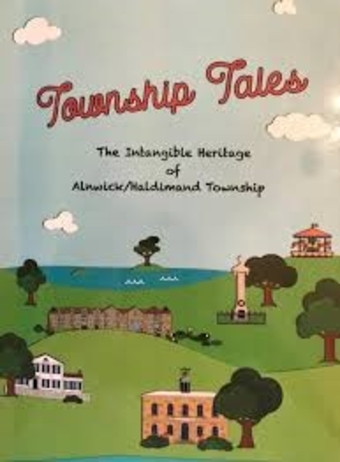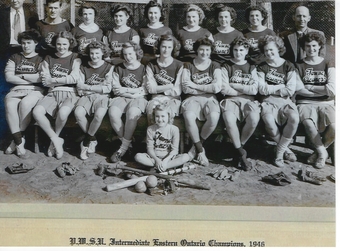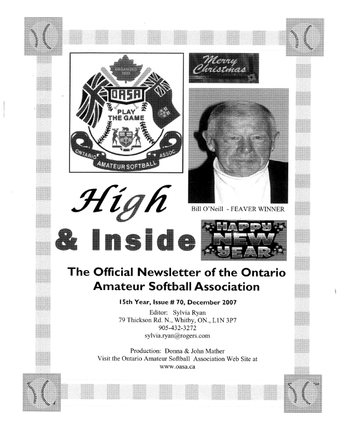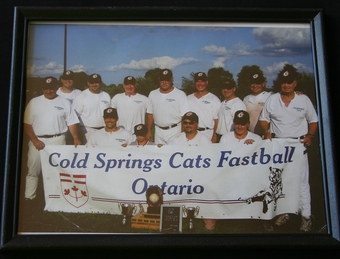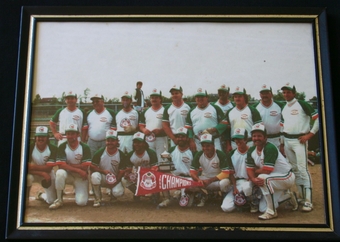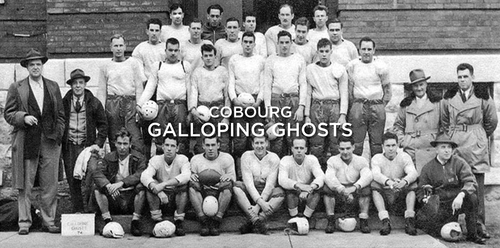Sports-Layton Dodge Obituary

Layton Dodge Loved His Home Town, Sports
By Cecilia Nasmith Dec 10, 2013 Northumberland Today
Layton Dodge's chair at Sommerville's is empty.
Dave Sommerville, owner of the downtown Cobourg sporting goods store, has been reflecting on what to do with it since hearing of Dodge's passing on Sunday.
Since his retirement as Cobourg's premier sports reporter, Dodge has been a regular in the store, taking the chair Sommerville's father Clarke used to occupy. It started out as a chance to enlist the Sommervilles' help in identifying the rafts of old sports photos he was giving away, and evolved into one of his favourite places just to hang out and visit with people.
Sommerville was one of those legions of Cobourg kids who grew up looking forward to the Wednesday paper because of Dodge.
"We ran home, grabbed the paper and opened it to the sports page to see if our name was there," he recalled.
Born March 14, 1937 to parents William and Kathleen, Layton Dodge grew up in Cobourg and attended Cobourg District Collegiate Institute (currently CDCI West) when it was the only high school in town. He went directly from high school to working for the Cobourg Sentinel Star, a precursor of Northumberland Today, his friend Rosie Bateman said.
By virtue of his life-long attachment to his home town, Bateman added, he always had a story to share — such as the fact that Col. Gordon King, after whom the library is named, was his Latin teacher.
Retired councilor Bob Spooner first encountered Dodge as a reader. He had been involved in sports reporting himself before he and his wife began looking to move to Cobourg in 1970. They picked up a copy of what was then the weekly Cobourg paper and, turning to the sports page, Spooner recalled, thinking, "Whoever is writing this is really doing the community a service."
Little kids hitting a home run, young goalies making a save, minor athletes who might never rate a mention in a bigger paper had their names there in print, Spooner said. "I thought, 'I have to meet this guy, because he writes so honestly and his information is really accurate.'"
That winter, Spooner got his chance when he began coaching minor hockey. They became instant friends, he reported.
Doing play-by-play hockey coverage for the local radio station in 1972, Spooner often met up with Dodge. Together, they broke down the barrier between print and electronic media when Dodge began doing occasional guest commentary.
"The public liked his analysis, his accuracy, his honesty. He never had a bias if he liked a coach or a player from the other team," Spooner said.
Longtime close friend Rod Baker remembers Dodge's support of the Cobourg Cougars Junior A hockey group, as well as for the young people in town. He remembers how much Dodge contributed to his own three children's lives when they were growing up in Cobourg through his work at the home-town newspaper.
"I think he was one of the best sports writers in this area and could have gone further. But he was very happy in Cobourg," Baker said.
"Layton was probably the biggest promoter of a lot of good athletes in Cobourg, but he would always find a way to get the average athlete — the kid who would never get noticed — to get his name in the paper if they had a good hockey game or made a good catch playing ball. He made the average athlete important. He had an uncanny way of doing that," Sommerville said.
He was also impressed with the range of sports his friend covered.
"If it was out there, he covered it," Sommerville stated.
Dodge would even hold off on his summer holidays so as not to miss covering the giant annual ball tournament in Grafton, where he would help with the announcing or do whatever else they needed.
"The only way you knew Layton was on vacation is, there was no sports in the paper. He would still be at all the games, but no sports in the paper.
"Cobourg has been so fortunate to have someone who cared so passionately about the town, so passionately about the youth of the town, and he showed it in many different forms," Sommerville said.
A modest individual, Dodge made substantial donations to organizations but also made the quieter substantial donations — paying for the high school wrestling tournament, for example, or even making significant contributions to the university and college educations of young people in need.
"He did so many things for so many people behind the scenes, the stories could be endless," Sommerville said.
A few years before Dodge was forced to retire earlier than he perhaps would have liked for health reasons, the editor combed old newspapers for a compilation of his best work for a book that was titled Spotlight On Sports.
A later publisher, Darren Murphy, found that Dodge remained deeply involved in the newspaper regardless.
“He would stop by regularly with some kind of a news tip or just to say hello to everyone," said Murphy, who is now publisher and regional advertising director of Eastern Ontario for Sun Media.
"He had a way of brightening up the entire building when he entered, and his contributions to the Cobourg sports community will never be forgotten.”
Cobourg Mayor Gil Brocanier said Dodge was an icon in the town.
"For so many years, he gave so much to so many people," Brocanier said.
"It's incredible, the work he did and the way he made so many young people growing up in Cobourg playing all sports feel important. He made it his mission to give almost every athlete — regardless of the level they were playing in — he made every effort to give them their 15 minutes of fame by mentioning them or something they had done in a particular game.
"It's a terrible loss to the sports community, and the community as a whole," the mayor stated.
"What really makes me happy is that he lived long enough to see the new sports complex," Spooner said.
As council's parks and recreation head during the project, he recalls how thrilled Dodge was with news of the facility and how he supported it with a donation that paid for the press box.
The Layton Dodge Press Box is the second town amenity that bears his name. Spooner recalls sitting down with the parks and recreation advisory committee prior to the opening of Legion Fields in July 1996 to name the three diamonds.
"The first name that cropped up for one of the diamonds was Layton Dodge," Spooner said.
In the end, the vote was unanimous to name the diamonds after Dodge, Clarke Sommerville and Jack Bevan.
Dodge will be missed very much, Bateman said. "I know how devoted he was to the youth of the town, and sport and the community. I think his legacy is that he inspired the youth of our town to be the best they could be in sports, and in life in general," she stated.
From seeing his friend spend so many pleasant days in that special chair in his store, Sommerville would characterize Dodge as the voice of reason.
"He could always find some middle ground and come up with a logical and reasonable solution. It's something I saw a lot of times that I found fascinating. He would sit back and watch it all and, in a heartbeat, come up with the right answer," he said.
Fairness extended to his sports coverage, which would occasionally single out a visiting player from a big city like Toronto. If a friend or relative sent a clipping to the young player, Sommerville said he would get a call to ask for 15 more copies, because that player would never get that kind of recognition in a bigger community.
And when a local player deserved a wake-up call or a slap on the wrist for any reason, Sommerville added, Dodge could deliver it in such a way that the player would remain on friendly terms with him afterwards.
"I think that gift was born out of his love for the community," he said.
In the end, he said, Dodge earned a singular honour — being known by a single name.
"In Cobourg, everybody knows Layton. It doesn't matter if you're 12 or 100, everybody knows Layton as Layton — or, in our case, Scoop. Nobody asks about Layton Dodge. It's Layton or Scoop. I think, over the course of time, with everything he's done for this community, he has gained that kind of recognition," Sommerville said.
"He deeply loved his mother and his family. He deeply loved Cobourg — the sports community and Cobourg in general.
"His legacy will live on and on and on, not only as a sports writer and member of the community, but also as a human being. There are not many people like Layton."
At Dodge's request, there will be a private graveside service at Cobourg Union Cemetery. A funeral service will be held in Trinity United Church Thursday at 1 p.m., and a celebration of his life will be held at the Cobourg Community Centre at a later date.
Reviewed August 2020

